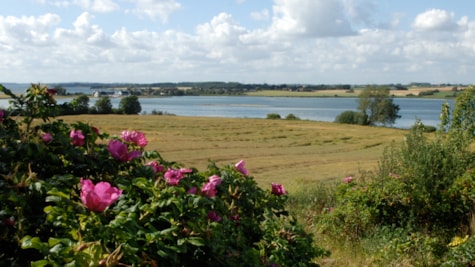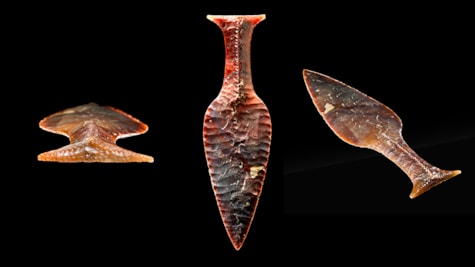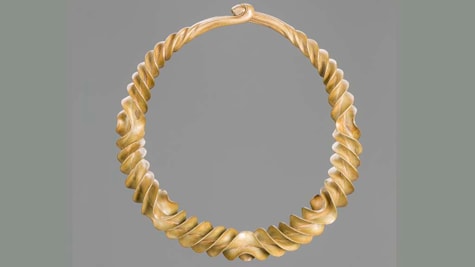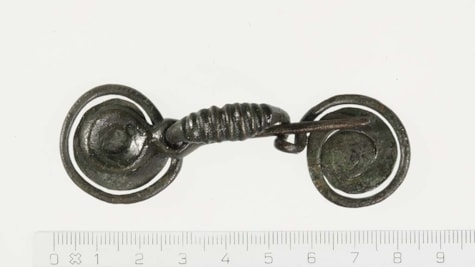Middelfart's historical cultural heritage
Distance: 81.26 Km
Part of the ancient finds and stories of the Viking Age, the Middle Ages and the Renaissance can still be experienced in Middelfart. Much of the history you hear most often originates from the Hindsgavl peninsula and Hindsgavl Castle. Below are a couple that originate from other parts of the municipality - and even a Danish cow!
Boyes Banke
Jens Henrik Christiansen Boye was a criminal specializing in counterfeiting, theft, arson and assault. He and his gang were notorious for their rampage in Vestfyn, but when a robbery turned into murder, it was over for Jens Boye. He was convicted of the murder of Niels Hansen and executed in 1856. It was done by beheading, the last beheading in Vestfyn, and as was the custom at the time, it had to be done close to the crime scene.
The hill was subsequently renamed Boye's Banks. The path up to the Bank can be a little difficult to climb, but it can be done.
Bug blood
One winter day more than 600 years ago, three knights were murdered in Middelfart. It was an outrage that went down in history because the three had dared to speak to a powerful king opposite.
When it then became spring, the blood of the slain sprang forth from the black earth where the outrage had been carried out. It has been repeated every spring ever since. Bug blood is the plant that otherwise bears other names such as Red Horsetail, Pestilence and Thunder. Incidentally, it was introduced as a medicinal plant - perhaps during the black plague of the 1300th century. In Middelfart, it is named after the most famous of the murdered.
In December 1358, Niels Bugge rode to Hald, Uffe Stigsen to Eskebjerg and Peder Andersen to Margård to negotiate with Valdemar Atterdag in Nyborg. Their intention was to get along with the ambitious king who poured large war expenses on them. But the king arrogantly goes to Zealand and lets his son negotiate with them. However, the three knights subsequently manage to have a meeting with the king in Slagelse. They get nothing out of it, and embittered, they have to travel home for eight days free rent, while the royal couple goes to Copenhagen to celebrate Christmas with the Swedish royal couple.
The three knights, on the other hand, only reach Middelfart, where they are reportedly murdered by local fishermen. Behind is the king's hand. The blame is thrown on the fishermen, who escaped surprisingly cheaply. Three houses in the town's Vestergade were forever fined, the so-called Buggespenge, which the town paid until 1874, when the Riksdag abolished the fine.
Niels Bugge is the most powerful of the three. He had fought his way up from a simple weapon to a respected knight who had a seat at the castle Hald near Viborg. His name has remained in history. In Middelfart, a street is named after him, a folk song is about him and an IC3 train bears his name. He's still a legend. We remember this when the blood-red sprouts burst forth from the bare ground.
Text by Peter Storm
Sacrifice find from Ejby Mose
Just over 6000 years ago, the people of Denmark began to cultivate the land. It led to a different outlook on life, with victims in water playing a central role. Finds in Ejby Mose show that the area from the beginning of the custom has been a favorite place to place victims to the higher powers. The sacrificial custom took place through most of prehistory, which is clearly illustrated by the finds in Ejby Mose.
The oldest safe sacrificial find in Ejby Mose consists of five planks of fine for axes, which were found in a stack lying on top of each other. More than 2000 years later, in the late Bronze Age, a victim consisting of a twisted collar is given to the higher powers. The sacrifice of the neck ring is interpreted as a sacrifice to the powers that particularly took care of the well-being of women.
The significance of the bog as a place of sacrifice lasted until the introduction of Christianity, where the custom of sacrifice disappears.
Source: Middelfart Municipality
Hindsgavl dagger
The dagger is a danefæ. It is made of flint stone and found on Fænø in the Little Belt back in 1867. The Hindsgavl dagger is exhibited at the National Museum in Copenhagen.
The Hindsgavl dagger is one of the finest examples of the flintsmith's work of that time, only 1 cm thick and 29,5 cm long.
When the dagger was found on Fænø, the island belonged to Hindsgavl Castle (today it is privately owned). It was a coincidence that Hindsgavl Castle's estate inspector was nearby when a little boy who was walking with his mother found the dagger. However, the boy only took note that he had found a nice stone. For a daler, the inspector bought it from the boy, and passed it on to the lordship of Hindsgavl Castle.
At the National Museum, the Hindsgavl dagger can be found in the exhibition Denmark Antiquity.
Source: National Museum
Updated by: VisitMiddelfart | mail@visitmiddelfart.dk




